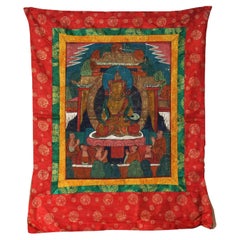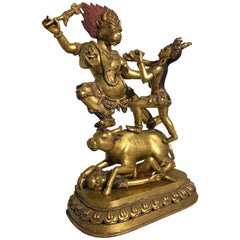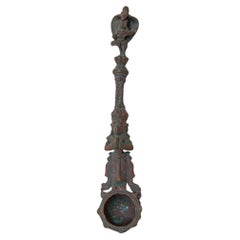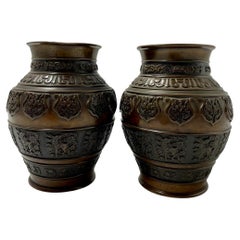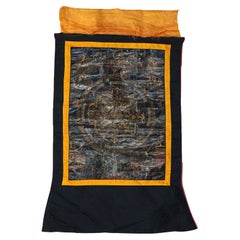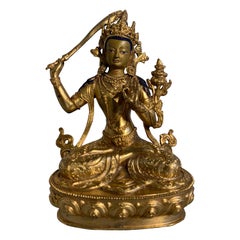Tibetan Asian Art and Furniture
to
33
121
13
130
9
801
485
220
185
151
78
58
49
30
27
25
19
15
14
13
12
11
4
9
53
68
9
37
16
5
2
2
1
1
1
1
1
70
52
44
35
32
133
97
88
21
19
139
139
139
Style: Tibetan
Antique Tibetan Hand Painted Silk and Canvas Thangka with Figures C1920
Located in Big Flats, NY
Antique Tibetan Hand Painted Silk and Canvas Thangka with Figures C1920
Measures- 37.5''H x 31''W x .25''D
Category
Early 20th Century Tibetan Tibetan Asian Art and Furniture
Materials
Canvas, Silk, Paint
Large 20th Century Nepalese Gilt Bronze Figure of Yama and Yami
Located in Austin, TX
A large and impressive Nepalese tantric gilt bronze figure of the dikpala Yama and his sister, Yami, early to mid-20th century (1920s-1940s).
Well cast and richly gilt, the buffalo headed dikpala (directional guardian) of the South stands upon the back of a bull trampling a prostate figure. Yama is portrayed here in his four armed form. His primary arms hold a flaming kapala (skull cup...
Category
Mid-20th Century Tibetan Tibetan Asian Art and Furniture
Materials
Coral, Bronze
Antique Fine Asian Ceremonial Indian Cast Bronze Puja Spoon 19th C.
Located in North Hollywood, CA
Fine antique ceremonial antique indian cast bronze Puja spoon with brown patina.
Indian Asian bronze Hindu ritual bronze spoon puja Achamani India Asia.
Antique ceremonial spoon used during Hindu worship for offering holy water to deities, from Maharashtra.
This Utharini is exceptionally well made, lotus shaped receptacle, the Hanuman sculpture...
Category
19th Century Antique Tibetan Asian Art and Furniture
Materials
Bronze
Pair of 19th Century Tibetan Bronze Vases
Located in Hoddesdon, GB
A beautiful pair of antique Tibetan bronze vases circa 1850s .
These vases feature a rounded, urn-like design, adorned with intricate bronze relief. stylised dragon motifs on the upp...
Category
Mid-19th Century Tibetan Antique Tibetan Asian Art and Furniture
Materials
Bronze
Antique Tibetan Hand Painted Silk and Canvas Thangka with Figures C1920
Located in Big Flats, NY
Antique Tibetan Hand Painted Silk and Canvas Thangka with Figures C1920
Measures- 31.75''H x 25''W x .25''D
Category
Early 20th Century Tibetan Tibetan Asian Art and Furniture
Materials
Canvas, Silk, Paint
Nepalese Gilt Bronze Buddhist Figure of Manjushri, Early to Mid-20th Century
Located in Austin, TX
A lovely Nepalese gilt bronze figure of Manjushri, the Bodhisattva of Wisdom, early to mid 20th century.
The Bodhisattva of Transcendent Wisdom ...
Category
Mid-20th Century Nepalese Tibetan Asian Art and Furniture
Materials
Lapis Lazuli, Bronze
Nepalese Gilt Bronze Figure of Bodhisattva Chenrezig, Mid-20th Century
Located in Austin, TX
A nice vintage early to mid-20th century gilt bronze sculpture of the Buddhist deity Avalokiteshvara in his four armed form, known as Chaturbuhja, or Chenrezig in Tibet.
Chenrezig, a form of Avalokiteshvara, the bodhisattva of compassion (known as Guan Yin or Kwan Yin in Chinese), sits in vajrasana upon a high double lotus pedestal. One pair of hands is clasped in prayer at heart level, the other pair of hands raised upwards at shoulder lever and holding discreet attributes, a mala (prayer beads) in one hand, a lotus blossom in the other.
Chenrezig is dressed in an elaborately patterned floral dhoti that covers his lower half. His torso bare, shoulders covered with a shawl and scarves that billow out around him. He is festooned with jewels, necklaces, bracelets, armlets, earrings, belt and a five pointed crown. The earrings studded with coral. The crown studded with turquoise. His face is cold painted with beautiful details. The hair has been pigmented blue with crushed lapis, indicating his peaceful nature.
The copper base plate is inscribed with a visvajra (double vajra...
Category
Late 20th Century Nepalese Tibetan Asian Art and Furniture
Materials
Coral, Lapis Lazuli, Bronze
Tibetan Traveler's Trunk with Painted Hide, c. 1850
Located in Chicago, IL
This antique traveler's chest from Tibet or Mongolia is one of the most unique trunks we've come across in our 20 years of collecting. Dated to the 19...
Category
Mid-19th Century Tibetan Antique Tibetan Asian Art and Furniture
Materials
Hide, Wood
Tibetan Gilt Bronze Arm of the Buddha, Early 19th Century
Located in Austin, TX
A stunningly graceful life-sized arm and hand of the Buddha, Tibet, late 18th or early 19th century. The hand is beautifully cast, with long, elega...
Category
Early 19th Century Tibetan Antique Tibetan Asian Art and Furniture
Materials
Bronze
Tibetan Bronze Incense Burner Finely Detailed with Mythical Beasts circa 1910
Located in Central England, GB
A Tibetan Bronze Incense Burner
This highly decorative piece is made from cast bronze which has a dark patina and Verdigris finish. It is cast with fine detail with figures and my...
Category
1910s Tibetan Vintage Tibetan Asian Art and Furniture
Materials
Bronze
Antique Bhutanese bronze depicting Buddha with excellent chiseling.
Located in Rio De Janeiro, RJ
Incredible old bhutanese bronze depicting Buda with excellent chiseling and traces of antique gold plating. Fantastic. For collector.
Category
Late 19th Century Bhutanese Antique Tibetan Asian Art and Furniture
Materials
Bronze
Antique Tibetan Wangden Rug with Red Open Field
Located in Milan, IT
A fairly unique example of monochrome Wangden rug, the latter being distinguished by the characteristic warp-face back. Typical for the group is the use of lanolin-rich wool which im...
Category
Early 20th Century Tibetan Tibetan Asian Art and Furniture
Materials
Wool
Tibetan Saddle Carpet with Five Blessing Medallions, c. 1900
Located in Chicago, IL
This unusually-shaped carpet is known as a "makden" and was originally used by a nomadic traveler as an artful covering for his horse. Placed between the saddle and the horse, the makden cushioned the rigid saddle and kept the horse warm in cold climates. Most under-saddle carpets include two to four holes near the center, through which the girth straps of the saddle were threaded.
Dated to the late 19th century, this Tibetan saddle carpet...
Category
Early 20th Century Tibetan Tibetan Asian Art and Furniture
Materials
Fabric, Wool
Tibeto-Chinese Seated Lama Figure, c. 1900
Located in Chicago, IL
Cast in brass with a rich patina, this seated figure is a Lama, a spiritual master and teacher of the Dharma in Tibetan Buddhism. The figure likely de...
Category
Early 20th Century Chinese Tibetan Asian Art and Furniture
Materials
Brass
Tibetan Gilt Copper Alloy Mask on Display Stand
Located in Atlanta, GA
An impressive copper alloy mask of Arhat, the disciple and follower of Buddha (also known as Luohan in Chinese) from Tibetan region circa 19th century. The larger-than-life mask has striking iconic facial features: large, rounded eyes under bushy eyebrows, wide nostrils, full lips and elongated earlobes. The molded mask is lined with a red lacquered line-like textile on the back with seams still visible on the edge. Masks with realistic rendition of Arhats were not as common as the fantastical and fierce deity masks...
Category
19th Century Tibetan Antique Tibetan Asian Art and Furniture
Materials
Copper
Tibetan Saddle Carpet with Scholars' Objects, c. 1900
Located in Chicago, IL
This unusually-shaped carpet is known as a "makden" and was originally used by a nomadic traveler as an artful covering for his horse. Placed between the saddle and the horse, the makden cushioned the rigid saddle and kept the horse warm in cold climates. Most under-saddle carpets include two to four holes near the center, through which the girth straps of the saddle were threaded.
Dated to the late 19th century, this Tibetan saddle carpet...
Category
Late 19th Century Tibetan Antique Tibetan Asian Art and Furniture
Materials
Fabric, Wool
Set of Two Tibetan Tsa Tsa
Located in Chicago, IL
This stack of two molded ceramic tsa tsa bricks depict Buddhist deities. Each was a meditation created in a monastery by a Buddhist monk in training. They were...
Category
Early 20th Century Tibetan Tibetan Asian Art and Furniture
Materials
Clay
Tibetan antique Pectoral, Turquoise and Fossil Coral from Himalaya
Located in Alessandria, Piemonte
O/5153 - Wonderful and rare antique pectoral with turquoise and fossil coral from Himalaya - Ladak (Tibet) -
Exceptional !!
PROHIBITED for SALE in USA...
Category
Early 20th Century Tibetan Tibetan Asian Art and Furniture
Materials
Coral
A late 19th century north Indian/Tibetan ceremonial ritual ewer. circa 1890
Located in Central England, GB
This fine ceremonial ewer was made at the end of the 19th century and originates from the north Indian or Tibetan region. It is made in a very elegant form from plain patinated coppe...
Category
Late 19th Century Tibetan Antique Tibetan Asian Art and Furniture
Materials
Metal, Copper
Large early 19th Century Khmer Terracotta Figure
Located in Shipston-On-Stour, GB
A very rare larger than life size late C18th/early C19th terracotta figure of a male diety, in the Khmer style, the figure sitting in a relaxed pose, with hair tied up and a serene c...
Category
Early 19th Century Cambodian Antique Tibetan Asian Art and Furniture
Materials
Terracotta
Antique Tibetan Small Elm Red Lacquer 2 Door Chest
Located in Chicago, IL
Antique Tibetan Small Elm Red Lacquer 2 Door Chest
This small elm wood cabinet from Tibet was used as storage for valuables and important documents. Orig...
Category
Mid-20th Century Tibetan Tibetan Asian Art and Furniture
Materials
Elm, Lacquer
Sacred Silver and Conch Shell Trumpet, Tibet, 19th Century
Located in San Pedro Garza Garcia, Nuevo Leon
Conch shell recipient and container for holy water used in ceremonies. Known as “Buddha ears”, they were mounted as a sound instrument. Such shells are important ritual objects in Tibetan Buddhism...
Category
19th Century Tibetan Antique Tibetan Asian Art and Furniture
Materials
Silver
A Monumental Gilt-Lacquered Bronze Ornamental Buddha Sculpture of Vajravidarana
Located in New York, NY
A Monumental Gilt-Lacquered Bronze Ornamental Buddha Sculpture of Vajravidarana:
A Masterpiece of Sino-Tibetan Craftsmanship, Late 19th Century, Qing Dynasty
This monumental gilt-lacquered bronze ornamental sculpture of Vajravidarana is an extraordinary and commanding piece of art, showcasing the pinnacle of Sino-Tibetan craftsmanship from the late 19th century. The figure of Vajravidarana, a powerful purification deity in Tibetan Buddhism, is meticulously sculpted to embody both spiritual authority and artistic excellence.
Vajravidarana is primarily known for his role in removing spiritual impurities and negativities. Unlike other deities associated with wisdom or compassion, Vajravidarana’s function is centered on purification and healing. He is typically depicted holding a vajra and a bell, symbolizing the cutting away of delusions and the resonance of divine truth. In this striking sculpture, Vajravidarana is shown holding a vishva vajra (the double vajra), a unique and powerful variation of the traditional iconography, which signifies ultimate protection and the dispelling of negative karma.
Vajravidarana: The Supreme Purifier and Protector
Vajravidarana is revered in Tibetan Buddhism as the deity of spiritual purification, called upon to cleanse practitioners of defilements and negative influences. His vajra represents the indestructibility of truth, while his bell signifies the wisdom that resonates through purification rituals. In this sculpture, the presence of the vishva vajra, or double vajra, enhances his association with supreme protection, ensuring the destruction of all spiritual obstacles and afflictions.
The figure’s powerful yet composed expression conveys a sense of unwavering resolve and divine authority. His posture, along with the carefully sculpted details of his robes and ornaments, highlights his function as a guardian against impurity. The inclusion of the vishva vajra rather than the usual single vajra reinforces his role as a supreme protector, capable of dispelling all forms of negativity and restoring balance.
Symbolism of the Mantras and Aureole:
Unlike deities that embody wisdom through duality, Vajravidarana’s iconography is centered on purification and exorcism. The aureole surrounding him is inscribed with sacred purification mantras rather than depictions of a consort. These mantras emphasize his function as a remover of obstacles and impurities, reinforcing his role in Buddhist healing rituals.
The presence of the sacred inscriptions elevates the sculpture’s spiritual significance, making it a focal point for meditation and ritual purification. Practitioners often visualize Vajravidarana radiating purifying light, dissolving afflictions and negative karma. This theme is mirrored in the sculptural repetition of the purification symbols on the aureole, reinforcing the deity’s role as a divine cleanser.
Gilt-Lacquered Bronze: The Artistry of Sino-Tibetan Metalwork:
The craftsmanship of this monumental figure reflects the expertise of late 19th-century Sino-Tibetan metalwork, where traditional Tibetan themes were infused with Chinese artistic sensibilities. Cast in bronze and finished with a rich gilt lacquer, the statue has an otherworldly glow, giving it an ethereal, almost divine presence. The gilding process—applied with exceptional skill—gives the sculpture a striking luminosity that enhances the fine details of the facial features, flowing robes, jewelry, and other elements of the deity’s attire.
The technique employed to create this figure speaks to the high level of craftsmanship that flourished during the late Qing Dynasty and early modern Tibetan art. The ornate details of the robes and the fine texture of the sculpture highlight the exceptional skill of the artisans who brought this work to life. The use of gold and lacquer not only reflects the preciousness of the sculpture but also its spiritual significance as an object meant to inspire reverence and meditation.
An Ornamental Sculpture of Monumental Scale:
Unlike smaller devotional objects, this sculpture is designed as an ornamental masterpiece, intended to make a grand visual and spiritual statement. Its monumental size allows it to dominate any space, offering a commanding presence that is both physically and symbolically impressive. In Buddhist practice, large sculptures of this nature are often placed in temples or meditation halls, where their imposing size and serene presence would encourage contemplation and devotion.
The grand scale of the statue further amplifies the spiritual power it is meant to convey. As a representation of Vajravidarana, it is not only a physical object of beauty but also a conduit for meditation, purification, and enlightenment. The scale of the sculpture also emphasizes the divine stature of the deity, highlighting his importance in the Buddhist tradition as the ultimate force for spiritual cleansing and protection.
Provenance:
Acquired in China in circa 1900
1905 Private Buddhist Temple, Northeast, USA
Private Sale
Solomon Treasure...
Category
Late 19th Century Chinese Antique Tibetan Asian Art and Furniture
Materials
Bronze
Tibetan asian art and furniture for sale on 1stDibs.
Find a broad range of unique Tibetan asian art and furniture for sale on 1stDibs. Many of these items were first offered in the 21st Century and Contemporary, but contemporary artisans have continued to produce works inspired by this style. If you’re looking to add vintage asian art and furniture created in this style to your space, the works available on 1stDibs include asian art and furniture, decorative objects, rugs and carpets and other home furnishings, frequently crafted with metal, bronze and other materials. If you’re shopping for used Tibetan asian art and furniture made in a specific country, there are Asia, East Asia, and Tibet pieces for sale on 1stDibs. While there are many designers and brands associated with original asian art and furniture, popular names associated with this style include and Liu Yi. It’s true that these talented designers have at times inspired knockoffs, but our experienced specialists have partnered with only top vetted sellers to offer authentic pieces that come with a buyer protection guarantee. Prices for asian art and furniture differ depending upon multiple factors, including designer, materials, construction methods, condition and provenance. On 1stDibs, the price for these items starts at $180 and tops out at $34,500 while the average work can sell for $3,000.
